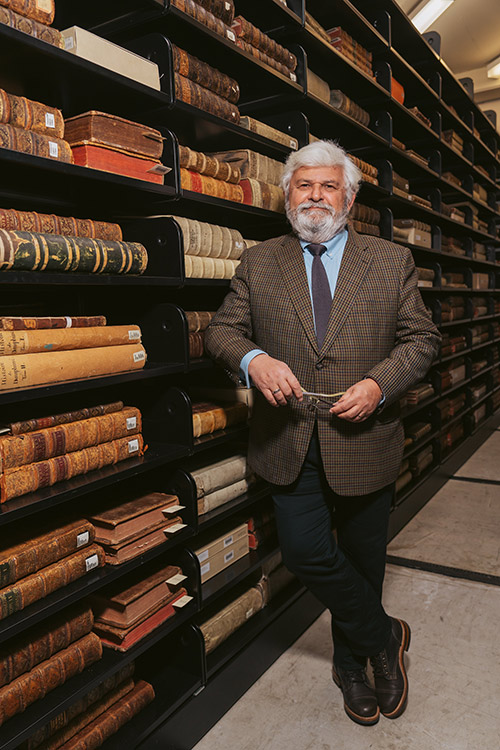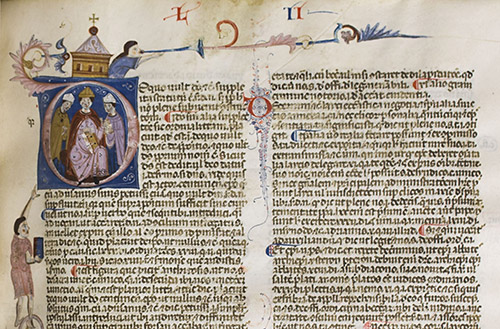But when the Covid-19 pandemic shuttered the law school in March 2020, one of the world’s best research libraries in the fields of religious and civil law closed its doors, too. That meant shutting out scholars around the world who use the center’s vast collection of 340,000 works.
Research libraries and museums have been digitizing their collections for years, but Robbins’ offerings were scant. Now, that’s changing: For more than a year, the center has taken on the arduous and painstaking task of creating research-quality electronic replicas of some of its holdings, including more than 350 manuscripts.
“The global shutdown and the inability to travel for a substantial period had a significant impact on scholars,” Senior Reference Librarian Jennifer K. Nelson says. “The question of access came front and center, motivating us to digitize those items that are unique to our collection.”

PDF versions of the first group of manuscripts should be available in early 2025, with high-resolution TIFF images available for purchase from the center. A second phase, which began in June, involves digitizing all the collection’s books printed before 1500, known as incunables.
Partnering with Backstage Library Works — which also handled the digitization of the vast collection at UC Berkeley’s Bancroft Library — the center has scanned more than 57,000 pages of incunabula and nearly 141,000 pages of manuscript.
UC Berkeley Law Professor and center Faculty Director Laurent Mayali says providing access to rare legal manuscripts from the medieval and early modern periods, as well as incunables, in a digital format is crucial for several reasons.
“First, it democratizes access to invaluable historical documents, allowing researchers from diverse backgrounds and institutions, regardless of geographical constraints, to study these texts,” he says. “Digital formats also enhance preservation efforts, minimizing the physical handling of fragile materials and extending their lifespan for future generations. Moreover, digitization facilitates advanced research techniques, such as text analysis enabling scholars to uncover patterns and insights that might be overlooked in traditional study.
“Ultimately, making these resources available online fosters a broader understanding of legal history and its evolution, enriching both academic discourse and public knowledge.”
Careful stewardship
The digitization process is delicate and difficult.
“The more fragile manuscripts need to be handled with greater care, but there are different kinds of fragility,” says Associate Librarian Jessie Sherwood, who prepared the most delicate manuscripts alongside Book Conservator Gillian Boal.
“We have manuscripts written on paper with iron gall ink that has burned through in places, so that requires care in turning pages and slip-sheeting. We have other materials where the binding is very fragile, so we don’t want to put any weight on it at all, and that we have handled carefully during the imaging process.”

Backstage captures the high-resolution images with dual overhead cameras, using a specially designed system to cradle the books and avoid undue stress on the materials.
The oldest work digitized is a fragment written between the mid-11th and 12th century. The longest item is 1,380 total images, covering 1,372 pages. The smallest is just 9.5 by 7 centimeters.
Some items were filmed manually, to avoid pressure from the glass plate system used to safely hold them. Items that were too tightly bound, had pages stuck together, or just considered too fragile weren’t digitized.
Books with unique characteristics posed a considerable challenge. For example, one volume has a chain binding, which required careful handling, and three papal bulls — official documents issued by the papacy — have the lead seals, or bullae, still attached.
“Our first priority with this project is to ensure the safety and meticulous handling of our manuscripts, and Backstage has been very responsive to our needs,” Robbins Assistant Director Emily Best says. “It was also very important to us that they were able to set up their system on site so that our staff can oversee the project.”
All hands on deck
The process of creating accurate metadata, critical both for cataloging and ensuring the digital files are searchable, for each element posed another challenge. As librarians and curators reviewed each item, errors that had been hiding in the catalog for years were exposed.
“It goes without saying that a project of this scope has demanded significant staff time to oversee the process and ensure accuracy, care, and completeness,” Best says.
The center’s holdings fall into several categories: civil law, religious law encompassing the canon law of the Roman and Greek churches and the Church of England, Jewish and Islamic law, and secular law. There are extensive collections in comparative law, jurisprudence, and legal history in general with an emphasis on continental Europe, as well as 100 single-folio manuscript legal documents from France, England, and the Papal Court, and 544 Catalan consilia printed between 1620 and 1756.
In-person visitors can also view microfilms and microfiche of thousands of manuscripts, including all the medieval canon and Roman law manuscripts in the Vatican Library.
The center’s influence extends well beyond its library. It organizes workshops, public conferences, lectures, and joint research ventures, hosts scholars and fellows, and offers funding to select students in UC Berkeley Law’s Doctor of Juridical Science (J.S.D.) program.
Now, Mayali says, the center’s outstanding collection of Roman law and canon law will be more accessible to scholars and available to a much wider audience.
“With digital formats, researchers can explore our important collections from anywhere in the world, facilitating collaboration and innovation across disciplines,” Mayali says. “This expansion of access not only enriches legal scholarship but also encourages interdisciplinary studies, bringing fresh perspectives to legal issues.
“The ability to uncover and analyze previously hard-to-reach materials opens new avenues for research and exploration, inspiring the next generation of legal thinkers and advocates.”
https://www.law.berkeley.edu/article/robbins-collection-digitization-religious-civil-law-access/




